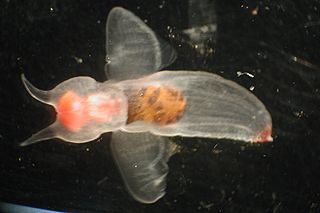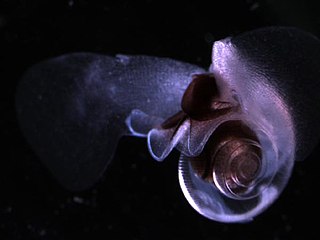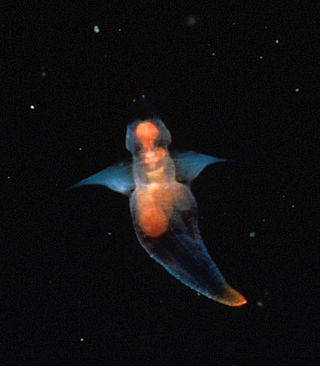
Sea angels are a large group of small free-swimming sea slugs, not to be confused with Cnidarians, classified into six different families. They are pelagic opisthobranchs in the clade Gymnosomata within the larger mollusc clade Heterobranchia. Sea angels were previously referred to as a type of pteropod.

Ancistrocheirus lesueurii, the sharpear enope squid, is the only species in the genus Ancistrocheirus and family Ancistrocheiridae. With a mantle length of 25 cm (9.8 in), this moderately sized squid may be found throughout the tropical and subtropical oceans. They tend to be found at mesopelagic depths.

The Limacinidae are a family of small sea snails, pteropods, pelagic marine gastropod mollusks in the clade Thecosomata.

Limacina is a genus of swimming predatory sea snails commonly known as sea butterflies in the family Limacinidae. This genus contains some of the world's most abundant gastropod species.

The Clionidae are a family of sea angels, which are a group of pelagic marine gastropods.

The Pneumodermatidae are a family of sea angels, or small floating predatory sea snails or sea slugs. They are pelagic marine heterobranch opisthobranch gastropod mollusks in the clade Gymnosomata.

Clione is a genus of small, floating sea slugs, pelagic marine gastropod mollusks in the family Clionidae, the sea angels.
Paedoclione doliiformis is a species of sea angel, a small floating sea slug, a pelagic marine gastropod mollusk in the family Clionidae.

Pteropoda are specialized free-swimming pelagic sea snails and sea slugs, marine opisthobranch gastropods. Most live in the top 10 m of the ocean and are less than 1 cm long. The monophyly of Pteropoda is the subject of a lengthy debate; they have even been considered as paraphyletic with respect to cephalopods. Current consensus, guided by molecular studies, leans towards interpreting the group as monophyletic.

Atlanta is a genus of pelagic marine gastropod molluscs in the family Atlantidae. They are sometimes called heteropods.
Peraclidae is a family of pelagic sea snails or "sea butterflies", marine gastropod mollusks in the superfamily Cymbulioidea.
Clione limacina, known as the naked sea butterfly, sea angel, and common clione, is a sea angel found from the surface to greater than 500 m (1,600 ft) depth. It lives in the Arctic Ocean and cold regions of the North Atlantic Ocean. It was first described by Friderich Martens in 1676 and became the first gymnosomatous "pteropod" to be described.

Limacina helicina is a species of small swimming planktonic sea snail in the family Limacinidae, which belong to the group commonly known as sea butterflies (Thecosomata).

Limacina rangii is a species of swimming sea snail in the family Limacinidae, which belong to the group commonly known as sea butterflies (Thecosomata).
Clione antarctica is a species of "sea angel", a sea slug, a pelagic marine gastropod mollusk in the family Clionidae, the "sea angels".
Limacina retroversa is a distinct species of swimming planktonic gastropods, belonging to a group of predatory sea snails known as sea butterflies (Thecosomata). The name Limacina retroversa describes the unique morphology of this sea snail, including its slug-like body and coiled, backwards-turning shell. They are typically found in the epipelagic zone of cold, polar waters, but can be found worldwide, in any ocean. L. retroversa are currently under threat, as their numbers are decreasing due to rising global carbon levels and other human-caused climate threats.
Cavolinia inflexa is a species of small pteropod.
Clione okhotensis is a species of sea angel, a pelagic marine gastropod in the family Clionidae.
Spongiobranchaea australis is a species of sea angel, a form of sea-slug plankton. It has a partially transparent body with small "wings" that it uses to swim in its habitat. It is classified as a pteropod.







